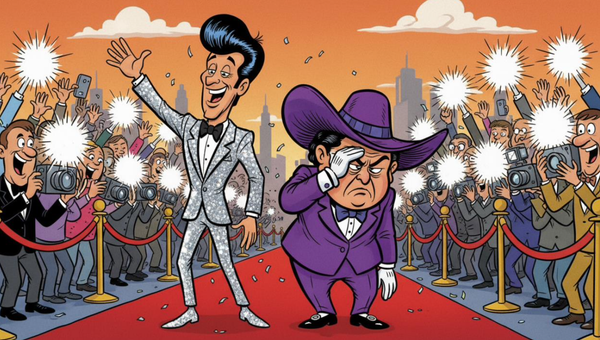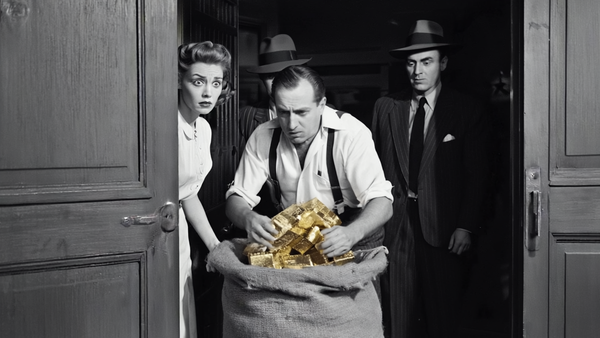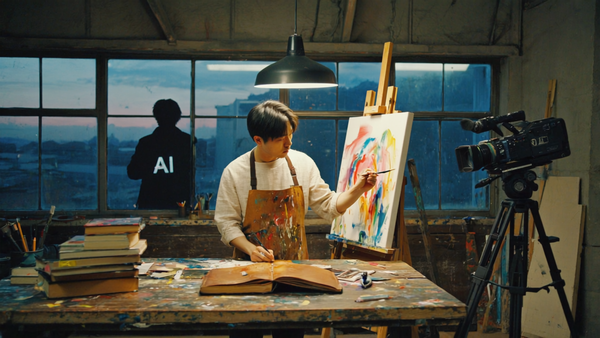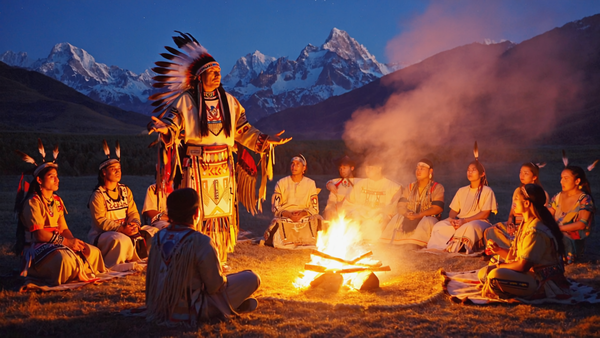"I'll Have Some of That Slop, please."
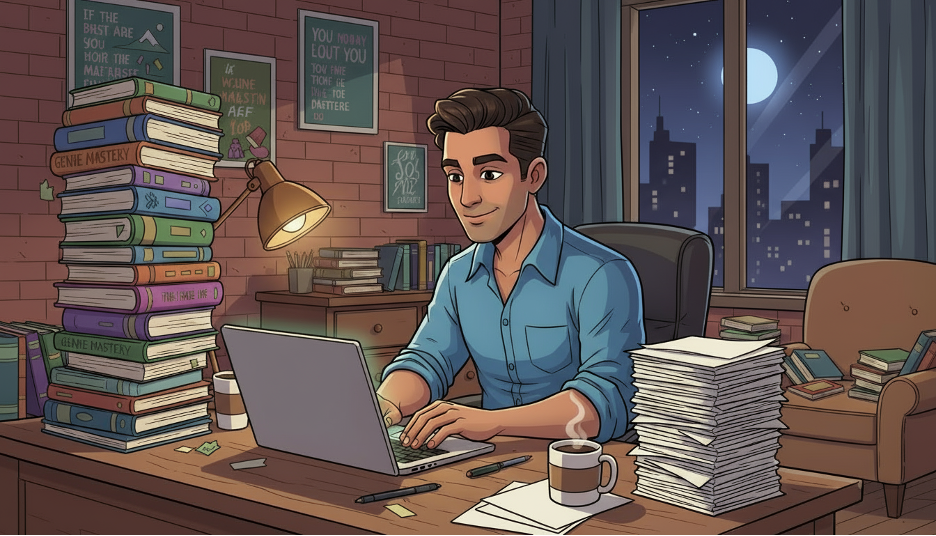
Listen to the essay
Listen and read along
Table of Contents
Michelin Chefs and Short-Order Cooks
What Is Slop?
On September 12, 2024, YouTuber Roman Abalin, known primarily for his main channel, NFKRZ (pronounced “No Fuckerz”), published a video currently titled “Why YouTube is SLOP Now.”[1]
In the video, he discussed how a lot of content on YouTube today is slop – meaning that many of the videos (and the channels) that exist on the platform today meet the following criteria:
1. They’re low quality
2. They’re mass-produced so that they can be released as often as possible
3. They’re clickbait
4. They’re made for the algorithm – the only purpose is to follow the trends
5. They’re not made with artistic integrity or passion; the videos exist to get views, provoke a reaction – positive or negative, and to get sponsors and ad money
Over a year later, the amount of sloppy content on YouTube has increased, and AI makes it even easier to produce such material. Many YouTube channels have become content factories. In other words, they aren’t there to tell stories or show creativity – they focus on mass producing content to garner views, likes, comments, shares, subscriptions, reactions, media attention, and generate profit.
For the audience, this is frustrating. You want to find great content on YouTube, but you’re met with a lot of junk. Imagine if your local movie theater only played bad films, and you had to find a secret door to catch the next big hit. That’s how many viewers feel about YouTube and many other content platforms.
But what does this mean for creative professionals, content creators, artists, entertainers, or whatever we’re supposed to call ourselves now?
The truth is, for many creative professionals, these content mills don’t just produce low-quality work – they create opportunities.
In his video, Roman argues that the creation of slop (4:32) might be necessary. He points out that the rising inflation worldwide has caused many, especially young people, to feel hopeless. It’s becoming more difficult to get rich and maintain financial stability. During such times, trying to make money takes precedence over any desire to produce great art. He supports others creating YouTube slop to earn money and even build generational wealth.
What he talks about is how many of us creative professionals live. Deep down, we might only want to make great art.
But at the end of the day, a living must be made.
Art Versus Content
As a kid, if you dream of working in the arts you likely dream about making great art. As you get older, in your teens, you want to ensure that you don’t create pointless entertainment – or content as we now call it. You want to make art. You don’t want to be a sell-out. Sometimes, you romanticize sticking to the underground rather than going mainstream.
You get annoyed at all the films that are made solely for entertainment and dumb down the audience. You get annoyed when the pretentious European arthouse film is only screened for one day in your local cinema, whereas Steven Seagal’s upcoming masterpiece will be on a loop for months on end!
In fact, you might have the rebelliousness that you don’t want to be a creator or an entertainer. You want to be an artist. You want to create something for yourself, hoping that an audience will be mature enough to appreciate it.
You may recall Bill Hicks’ standup routine on marketing and advertising, where he said to the audience:
“By the way if anyone here is in advertising or marketing…kill yourself.”
He goes on to rant about how horrible these industries are and that there’s no rationalization for working in them. As a rebellious aspiring artist, you may heed these words as gospel. You don’t want to create for the sake of promoting a product or service.
Instead, you dream of a warm reception for your art. You imagine you’ll become a kind of celebrity—big or small. Your art will be discussed by audiences and critics alike. You’ll hire professional speechwriters to craft your acceptance speeches at the various award ceremonies where your work is recognized.
But this is the fantasy that’s sold to all of us. This fantasy is only a reality for a small portion of creative professionals.
For most of us, we wish to be working creative professionals. If we can pay our bills through our creativity and have a little bit left over to pay for our leisure, then what more can we ask for?
For some of us, this does mean that we’ll do work that won’t satisfy our souls. We might even do work that we consider mediocre. We might be glad we had to sign non-disclosure agreements, because we wouldn’t want to get credit for the awful work we produced. We did the work solely for the money.
But how did we get here?
Economics and The Arts
With the fiat monetary system we all live under, you don’t need a PhD in Economics to see that our money becomes more worthless each day. As a result, many of us are eager to make a quick buck – and those who create content are no different. Perhaps that’s why we now refer to ourselves as “content creators” instead of “artists.”
As the cost of living increases, and our wages don’t match up, we are often forced to make money as quickly and as often as possible. Creating content is just one of many ways to ensure a steady cash flow.
There’s been a long-standing argument that the quality of our art – regardless of the medium – has deteriorated, due to economic instability and the lack of sound money.
In his book, The Fiat Standard, economist Saifedean Ammous has argued that our fiat currency system brings about a high time preference. This refers to favoring immediate rewards rather than future benefits.
He focuses on discussing how the fiat standard has led to the construction of uglier and inferior buildings. The craft of architecture has essentially degraded under this system, he argues.[2]
While he discusses architecture, the same logic applies to other art forms. In a time when everyone wants clicks, likes, comments, subscriptions, and hopes to go viral, many creators have a high time preference.
Many of us desire instant gratification and quick fame. Building an audience and a quality body of work takes time – it might take several years. Many creators refuse to admit this, which causes many to focus on producing low-quality content.
We tend to assume that our favorite creators are overnight successes. But this is rarely the case. People want the success of their favorite creators, but not the struggle and the journey they went through to get there.
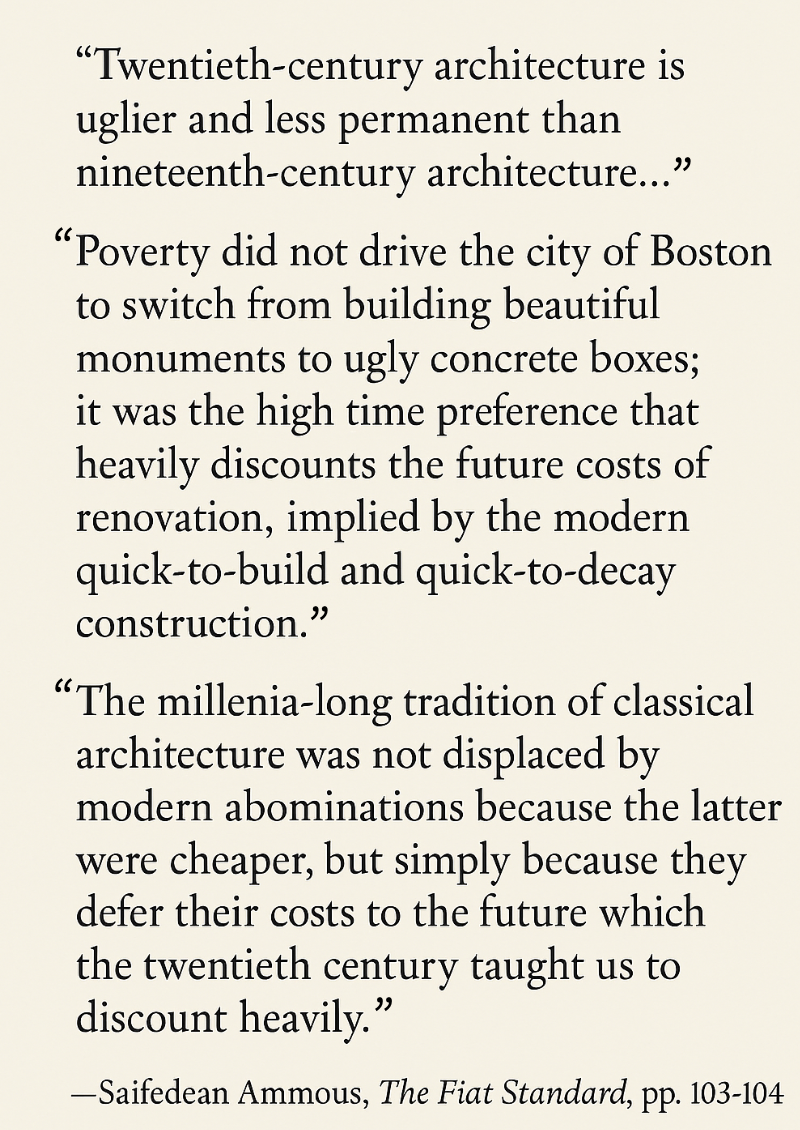
It’s why many creators may start creating with the intention of making money rather than the intention of making great art. It’s why established artists may eventually become jaded and focus on making money, playing it safe, and pandering to their audiences – rather than creating challenging art.
This is what led to the emergence of content mills or content farms. Endless blog posts are published on a variety of websites to promote an affiliate link here and there. YouTube channels produce video after video to get attention, traffic, and to earn through ad revenue.
For seasoned artists and audiences alike, these content farms are a nuisance. But for many working professionals, especially beginners, they have been a boon.
Working for content farms is a great way to build a portfolio, to establish contacts, receive letters of recommendation, learn your craft, and, most importantly, to earn a living.
Once a content creator becomes financially stable, they might keep producing content just to make money. However, they could also try to create meaningful art. Often, being financially stable is a prerequisite before starting to make art instead of content.
Since we don’t have a sound financial footing, the only option is to become financially stable and have a regular cash flow before we can think about creating art. This isn’t true for all creators, but it’s true for many of us.
Adam Sandler often played the same type of character in his films – until he showed his incredible versatility in films such as Spanglish, Punch Drunk Love, and Uncut Gems.
Woody Allen made slapstick films such as Take the Money and Run and Bananas before transitioning to more sophisticated comedy-dramas like Annie Hall and then making deeply thoughtful artistic films such as Crimes and Misdemeanors and Match Point.
Often, you’ll have to build a steady career and a personal brand before you can showcase your true talents. Many of us working creatives spend most of our time creating content for the money. Occasionally, we hope we can land a gig that we find artistically satisfying. Or we hope we’ll have the funds to produce at least one project that satisfies our souls and artistic desires.
Werner Herzog couldn’t give up his dream of making the film Fitzcarraldo, which was documented in the film Burden of Dreams.
Deep down, most creative professionals have at least one Fitzcarraldo they’re dreaming of making.
Playing to the Algorithm
As many of us create content for the internet, we often end up working for the algorithm, rather than working for our own unique artistic vision.
A tragedy occurs? A YouTuber will cancel his wedding anniversary celebration to quickly churn out a video about it.
A head of state resigns? Fire up ChatGPT to write a blog post about it and publish it immediately – you can always human-edit it later.
A new slang term has entered the lexicon? It’s time to fire up the meme generator!
Many creators today are making content solely for attention. They hope that this attention will create opportunities for monetization. For artists and consumers alike, this is often disappointing.
Bloggers may research keywords that are suited for Search Engine Optimization (SEO) and write blog posts that’ll be at the top of search engine results pages. Many of us write for the search engines, rather than writing for an audience.
But, as you become a working creative professional, you also understand why this happens. And at times, you simply can’t judge harshly.
Money Needs to Be Made
Content has become a way to build a sustainable income. Rather than creating content to promote a brand or to make art for art’s sake, some create media to climb out of poverty or to become rich. Money is the only motivation.
This has always been the case as there are plenty of artists who created work with the sole intention of earning an income from it. They have opted to make work that is commercial and has mass appeal.
However, in the internet age, there is a strategy to make money based on whatever’s profitable. If Topic A is profitable, one will write about Topic A. Once Topic B becomes popular, a series of YouTube videos will be made about Topic B. If one has to switch sides, politically, to earn an income, one will switch sides.
In our internet age, especially with the rise of AI-generated content and the 2016 US Presidential Election, there’s constant discussion about fake news and the dangers it poses. But, while fake news is an issue for some, it’s a money-making opportunity for others.
In Veles, Macedonia[3], a young man was able to become the toast of the town thanks to his fake news business.[4]
Dimitri (not his real name) and many other teenagers like him would post fake news articles on social media related to the 2016 election. Fake news writers earned an income through pay-per-click (PPC) advertising.
He claimed to have made $60,000 in six months. This was much more than what his parents earned, significantly higher than the average income of his town, and quite a decent salary for one of Europe’s poorest countries.
But it wasn’t just Dimitri who had benefited from being able to produce sensationalist content. In Serbia, Nebojša Vujinović Vujo, a DJ, has perfected the art of profiting from lots of content.[5]
He would buy domain names of once-popular websites and then fill them with AI-generated articles, even though he claimed not to be a fan of AI. Fan or not, generating articles with AI proved profitable for him. The articles included backlinks to actual brands’ websites – and this is how he earned his money. The AI-generated articles provided an opportunity to promote brands and help them rank higher in search engine results pages.
No doubt there are many that would scoff at both this young Macedonian man, now in his twenties, and the Serbian DJ who hates AI but loves the money he makes from it. But both of them have not had opportunities available to those in the wealthiest nations of the world.
According to the International Monetary Fund (IMF) the projected gross domestic product (GDP) per capita for Macedonia, measured in purchasing power parity (PPP) is $28,720. For Serbia, it’s $30,910.[6] To put this in perspective, Europe’s largest economy, Germany, had a GDP per capita measured in PPP of $62,829 in 2024.[7]
As discussed in the previous section, economics plays a role in the type of creative work we produce. When one doesn’t live in the strongest economy or you don’t have financial stability, one might be more focused on making money than producing great art.
For many, fake news and AI slop have created opportunities. For those seeking to build an income, the tendency to read fake news and even digest slop has been a blessing—whether this is a fact we feel comfortable with or not.
For Dimitri, opportunities in his town and his country were limited. For Vujo, he fled Bosnia after the break up of Yugoslavia, and had to start a new life in Serbia – as did countless of citizens of the former Yugoslavia. Since the breakup of Yugoslavia, its former members, such as Macedonia and Serbia have improved economically, but not to the extent of the wealthier Western European nations.
As Roman Abalin discussed in his YouTube video mentioned earlier, slop might be necessary. It can help people lift themselves out of poverty and survive during this time of global economic instability and never-ending inflation.
Unfortunately, the worst part of earning money through constant content output is rage bait content. This is far worse and miserable than any slop content. This is especially popular in the American political context.
Instead of serving as spaces for meaningful debate, platforms like YouTube or Instagram are used to incite outrage and profit from it.
Here’s what happens:
Bob is a talented debater. However, instead of engaging with another skilled debater, he chooses to pick on Bill, who has opinions but lacks the skill to articulate or defend them.
Bob traps Bill with a “gotcha" question, and Bill can't respond. This scene is edited with loud sound effects and a clickbait headline. Bill's humiliation gets millions of views on YouTube.
Then, in the description, Bob promotes his course, digital products, or whatever else he needs to keep his media empire running. The Bobs in our world are always preying on the Bills to help grow their wealth.
Of course, it’s not just about political content. A lot of careless work, including AI-generated content, is created to stir hatred, divide people, fuel anger, and make money.
An Instagram account attacking all foreigners, a YouTube channel targeting all natives, news articles criticizing all major political parties – all written by the same person under different pseudonyms. The internet is often used as a dumping ground for some creators who won’t let ethics interfere with their profits.
This is the most awful part of using content to make money. What’s the solution for it? There probably isn’t. But slowly, audiences are realizing that many of their favorite content creators are indeed grifters – only interested in jumping on the political trends that’ll bring them attention, and eventually, profit.
AI and Creativity
More creators are adopting AI, and it seems those who resist might just be late to the party. Of course, there’s a valid backlash to AI and real concerns that it could reduce opportunities for creative professionals. There are many fears about AI. Right now we have to verify that we're human to use AI. Will the time come when AI has to verify itself to use us? But I digress.
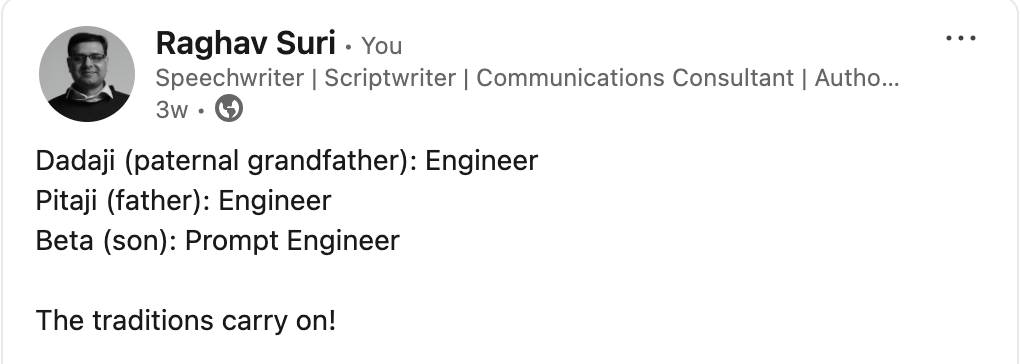
I’m more interested in exploring whether AI can help us be more creative.
On January 23, 1991, John Cleese delivered a famous speech on creativity[8], which he later expanded into a book titled Creativity: A Short and Cheerful Guide, published in 2020.
In the speech, he talked about the conditions needed for someone to be creative. One that stood out to me was the importance of the open mode. In the open mode, a creative person can experiment easily. The open mode doesn’t have the pressure to complete an assignment – which can often block creativity and lead to poorer results.
In his book, Cleese talks about the playfulness that children have but adults find hard to embrace. Creative adults still know how to play. They, like children, aren’t bound by rules and don’t fear making mistakes. This play is essential for creativity.[9]
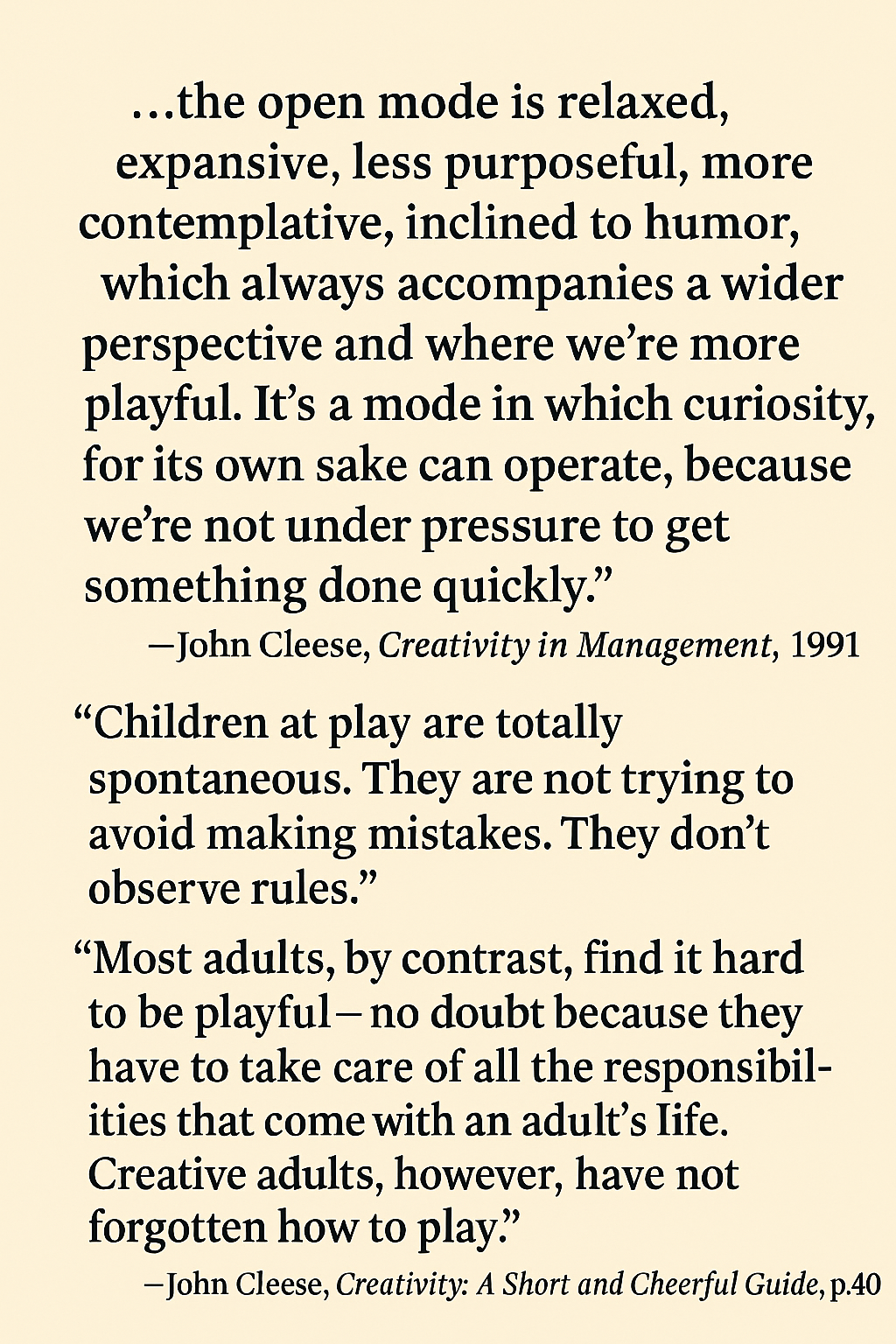
Now, we revisit the question of whether AI hinders or boosts creativity. An argument against AI is that it’s the lazy way to produce art—and whether AI can create art at all.
If you write a prompt and it creates a beautiful image, can you really say that you have been creative? Instinct tells me no. But if the image is beautiful, it must be because you understand what makes a great image. Of course, you’ll be a lot more creative if you draw or paint the image on your own.
AI alone doesn’t make you creative. You have to put in some effort. Still, AI can help you become more creative through practice. Many AI-generated songs may sound catchy but are usually simple. AI writing can be clear and informative, but it often feels overdone and not authentic. You don’t need an AI detector to see that it’s AI.
In other words, AI generations have made us understand what made human-made art so great. It’s the imperfections, flaws, and authenticity that make us appreciate art.
But playing around with AI also allows us to experiment at a much more affordable rate. AI tools become our sandbox where we can play around.
We might not have access to a high-quality camera and studio to produce a professional image. We can experiment with AI to make prototypes of what we want to create by hand. We can also use AI music tools to develop a demo of a song we aim to produce. Then, we can decide if our lyrics work or determine which instruments, tones, and structures to use in the final version.
I’ve played around with AI tools to create images, videos, audio narrations, and songs. It’s been fun though I’ve not found that tools can replace the human experience. That doesn’t mean that we shouldn’t use them.
Just as we use CGI today to depict animal slaughter instead of actually slaughtering the poor animal, I see a place for AI to complement, not replace, human artistic creation.
Based on my experience with AI in creating audio voices, I haven’t been very impressed. I think it’s useful for making demos of content you're planning to eventually release. However, I've had the privilege of working with many talented voice actors for audio documentaries, plays, audiobooks, ads, and speeches – and I can confidently say that none of them can be replaced by AI.
While AI is being used to produce more slop than a human could, I also see some people becoming inspired to pursue the arts after playing around with AI. Will everyone who uses AI pursue a career in the arts? No. But I do feel that many will.
I’ve played around with Suno to make AI songs. I write the lyrics by hand and then based on my prompt, Suno records music and vocals. The songs are quite good, but again, not up to the level as any of my favorite artists.
However, since playing around with Suno I’ve become more interested in producing music on my own – and have bought two synthesizers as a result. While this won’t be everyone’s experience, I believe many AI music creators will want to finally learn that instrument they’ve avoided for years. If they’ve used AI to write lyrics, they’ll use their human ingenuity to refine the lyrics. Soon enough, they’ll write lyrics from scratch – realizing what a rewarding experience it is.
Suno’s CEO, Mikey Shulman, sparked controversy when he said,
“I think the majority of people don’t enjoy the majority of the time they spend making music.”[10]
I’d respectfully disagree with Shulman here. No doubt Jimi Hendrix was frustrated every now and then when he was a young boy learning his skills. But when he became one of the greatest guitar players – even though he’d disagree with that statement – things changed.
When Jimi Hendrix played the guitar, he was in a trance. Ravi Shankar was in heaven and made you feel liberated when he played the sitar.
AI tools will help us experiment and at times they will create the final product. And yes, they will continue to make meaningless slop just to earn views, spark reactions, and rake in cash. But they’ll also serve as the playground we’d spend hours in as children. They’ll inspire many people to finally pursue their art.
It is much easier to have AI create something from our prompt than it is for us to do the work ourselves. But it’s doing the work ourselves that keeps us alive.
While researching my book Influenceza: A Language Guide for Creating and Understanding Influence, I revisited an essay I first read in a university class. The essay was “Politics and the English Language” by George Orwell. Since it had been over ten years since I last read the essay, I needed to refresh my understanding of it.
It would have been much easier to ask ChatGPT what the essay was about. But then I’d be going off ChatGPT’s interpretation rather than my own. It was a pleasure to read and re-read the essay until I understood how I could discuss it in my book.
Creating art can sometimes be tedious and stressful. It can bring joy, but it’s not always enjoyable. Still, it’s always meaningful. That’s why we get up each morning, and after a particularly successful day, it’s what helps us sleep soundly at night.
AI is here to stay. But the human desire to create will never go away.
Michelin Chefs and Short-Order Cooks
As a teenager, I discovered the parallel cinema movement in India. These were artistic films initially made in West Bengal and were strongly different from the commercial Hindi cinema, better known as Bollywood.
I enjoyed watching these films and would spend my money on buying DVDs of movies made in Hindi, often starring many famous Hindi film actors, but with more meaningful and serious stories.
Watching these films didn’t make me fall out of love with the commercial Hindi cinema that I’d enjoyed since I was a kid. But as any precocious cinephile, I felt upset that so many films were just pure entertainment and didn’t want to be anything beyond that. I felt upset that audiences appreciated mindless entertainment over more artistic films.
Similarly, when I found The Criterion Collection, I discovered films from around the world that truly helped me appreciate cinema. I’m glad I’ve had the chance to explore the great auteurs of cinema, and there are still so many great films I need to watch.
However, as I’ve grown older and now face the responsibilities of life, I have developed an appreciation for commercial cinema that matches my appreciation for artistic cinema.
Because the truth is, we need art and entertainment. We can’t have one without the other. Both are essential. While some low-quality content is truly slop and might disappear if we had sound money, not all mass-produced content is slop.
Pulp novels were often produced en masse and for the sole purpose of entertaining the reader. They are as enriching as a serious detective novel by Agatha Christie or Sir Arthur Conan Doyle.
There’s a pleasure in eating a great meal prepared by a Michelin star chef. And nothing beats going to an American style dinner late at night and eating a big plate of eggs, toast, hash browns, and pancakes – for under five bucks.
Michelin star chefs and short-order cooks make our lives more enjoyable. I tip my hat to both of them.
Working As a Creative
Many of us would dream to have a career like Daniel Day-Lewis or John Cazale, where our work isn’t necessarily prolific, but everything we’ve been involved in turns to gold. John Cazale only acted in five films as his career was cut short due to his untimely death. But those five films are among the greatest films in the history of cinema.[11]
But you quickly realize that much of your work is only to pay the bills and doesn’t offer any creative fulfillment. Some of the work might even make you feel embarrassed. Sometimes, you’re thankful for non-disclosure agreements because you’d rather not reveal your involvement in a project!
However, you’re grateful for such opportunities. Being able to create content or make art for a living is a blessing. It’s a rare privilege, and most of us will have to do it as a hobby or at best, a side hustle. If your content is your main source of income or if you can survive and live a decent life from creating content, you truly are lucky.
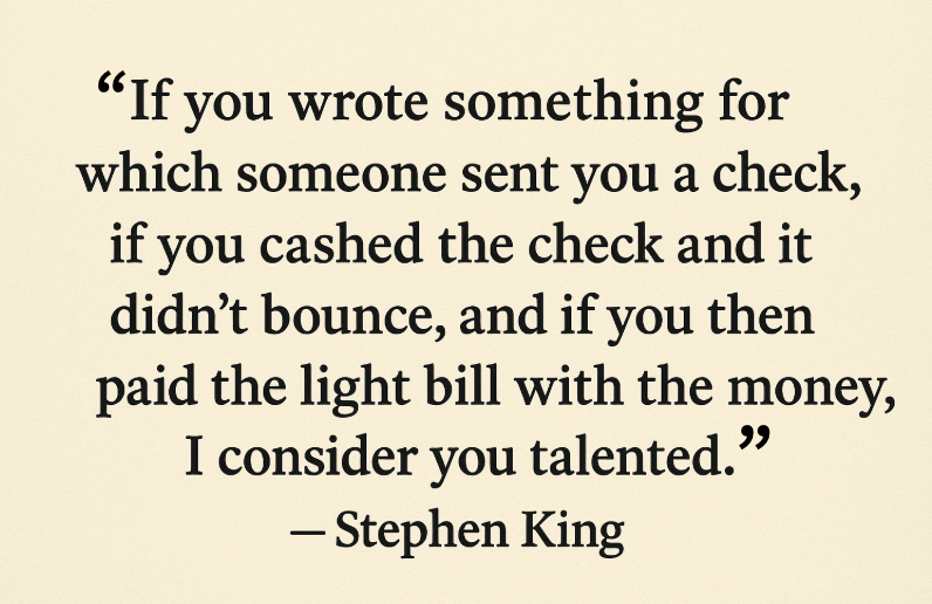
Some creators may constantly feel depressed if they believe they’ve never produced anything truly artistic. The unsuccessful actor might have appeared in many films but still feels like they've accomplished nothing. A screenwriter may have written several low-budget B-grade movies that almost no one has seen and are unlikely to be watched again.
It’s not enough for some of us to just earn a living through our creativity. We aim to produce at least one piece that resonates with an audience. We set aside personal projects, sometimes never finishing or even starting them, to make money instead.
You’ll ghostwrite someone else’s novel, but never finish your own. You’ll direct a TV commercial, but your feature film never gets made. This is a harsh reality that many of us face.
Many creatives find this tough to accept.
Some creatives can become jaded with their profession. If one only works for money and hasn’t produced great works, one may decide to call it quits.
Some creatives wouldn’t work unless they get paid for their work. Writer Chuck Klosterman has stated he writes what’s going to get published, and he doesn’t feel compelled to write otherwise.[12] Jazz musician Miles Davis, on the other hand, stated that he’d be a musician even if no one heard him.
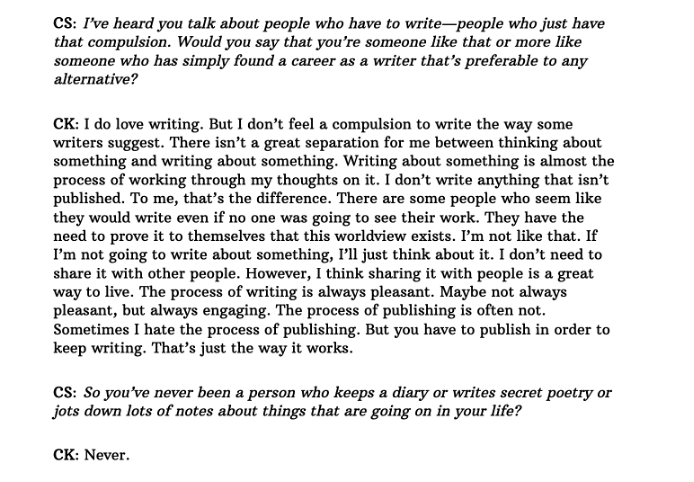
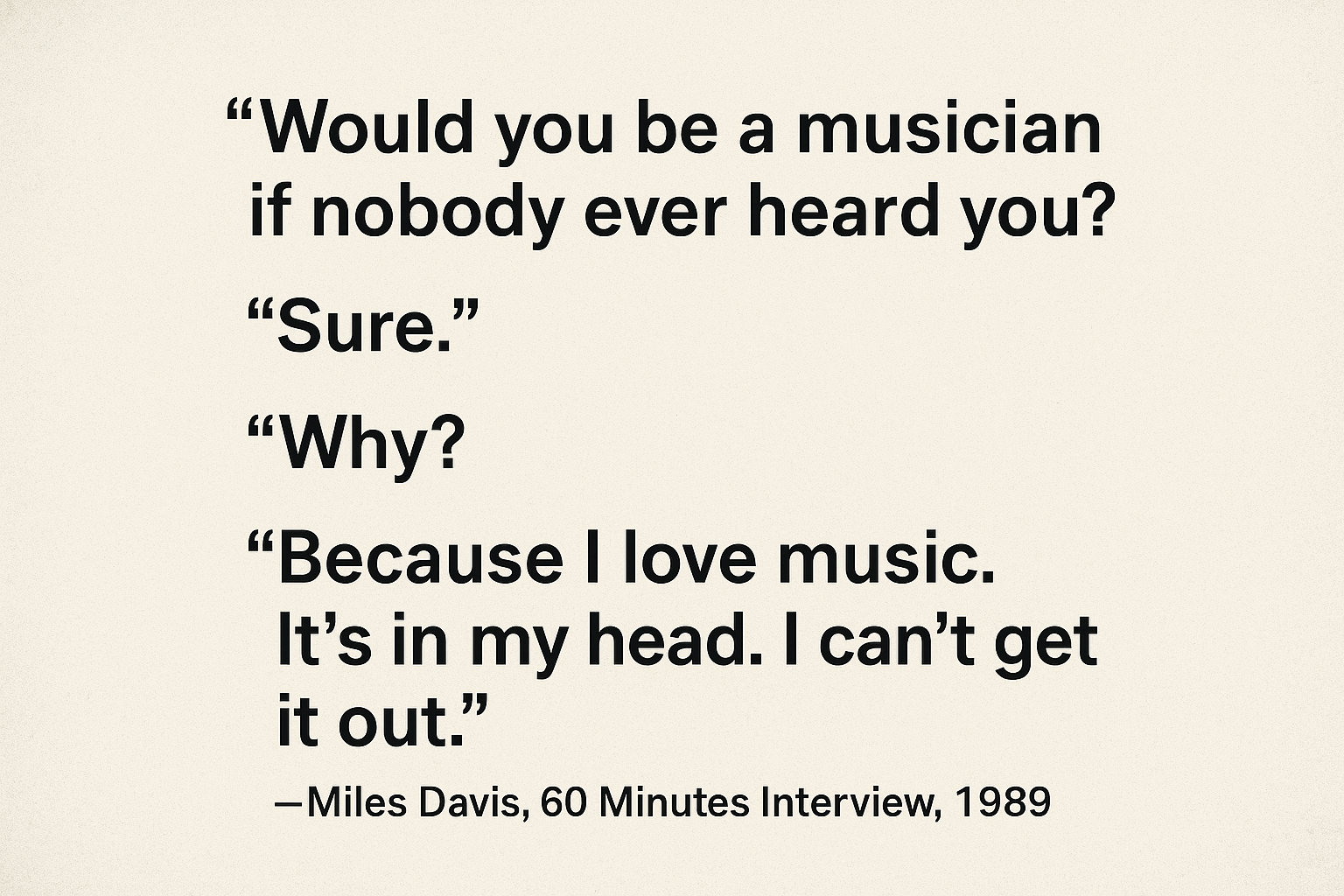
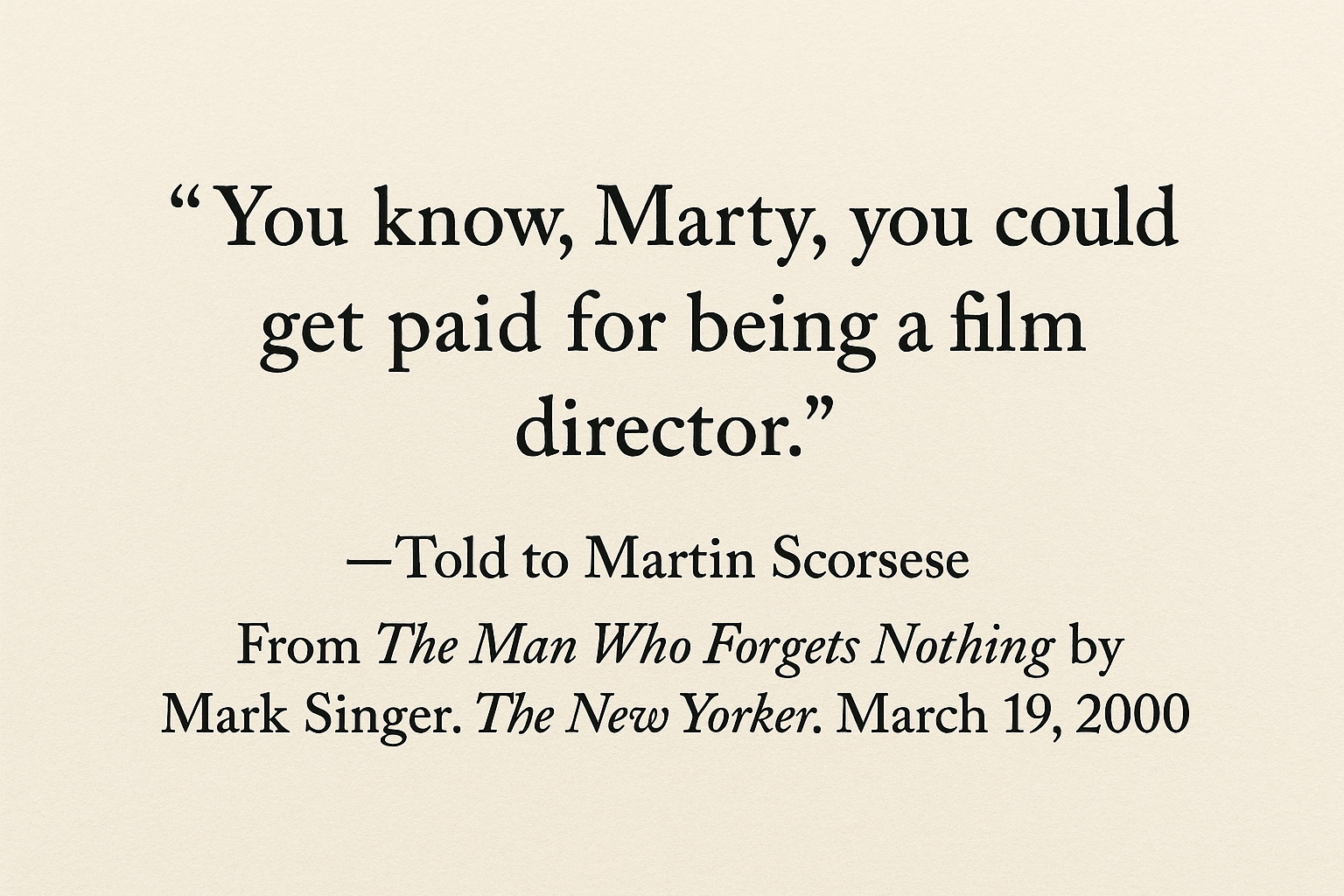
Some of us may see ourselves in Chuck Klosterman, while others relate more to Miles Davis. We might give up chasing our creative passions if we can’t earn a living from them. We’ll just think about our novel, play, film, or songs. Meanwhile, others will publish novels, stage plays at local theaters, release their films and songs, and not really care that their work never reaches an audience.
It's often saddening to know that we have so many artists who simply won’t share their work because they can’t earn a living from it. As a fan of Chuck Klosterman’s writing, I feel my life is richer from reading his books, columns, and essays. Likewise, the music of Miles Davis brings me peace and keeps me grounded.
How sad would it be if we never got to read Klosterman’s writing? How sad would it be if Miles Davis made music, but we never heard his genius?
For creative professionals, we often face this dilemma. If we can’t make a living from our work, are we wasting our time? Should we just think about making art but not bother executing it? Or should we create art even if it’s just a hobby and won’t receive wider appreciation?
Instinctively, one may consider the latter. If you like making art, then make it regardless of whether it gets discovered or not. But it’s not so simple. As kids, doing art as a hobby is fun. As adults, making our art can feel like work – even if we don’t get paid for it.
We’ve heard the adage that if we find a job we love, we’ll never work a day in our lives.
However, that isn’t entirely true for all artists. If you enjoy writing, you might still find it tedious and stressful at times. You’ll likely be grateful that you get to write for a living and that you don’t have to spend all day preparing balance sheets. But it still feels like work.
It can still cause you stress. The more responsibilities we have—bills, family obligations, and so on—the more burdensome making art might seem to some of us.
This leads many to quit. Rodney Dangerfield didn’t have a particularly successful stand-up career early in his life. Performing under the name Jack Roy, he would perform at comedy clubs, wrote material for other comics, and even worked as a singing waiter. However, this wasn’t enough to make ends meet – especially since he was married and had two children.
He eventually quit show business to start an aluminum siding business. It would be several years until he tried comedy again, and the second time around Jack Roy became Rodney Dangerfield – and he eventually became a comedy legend.
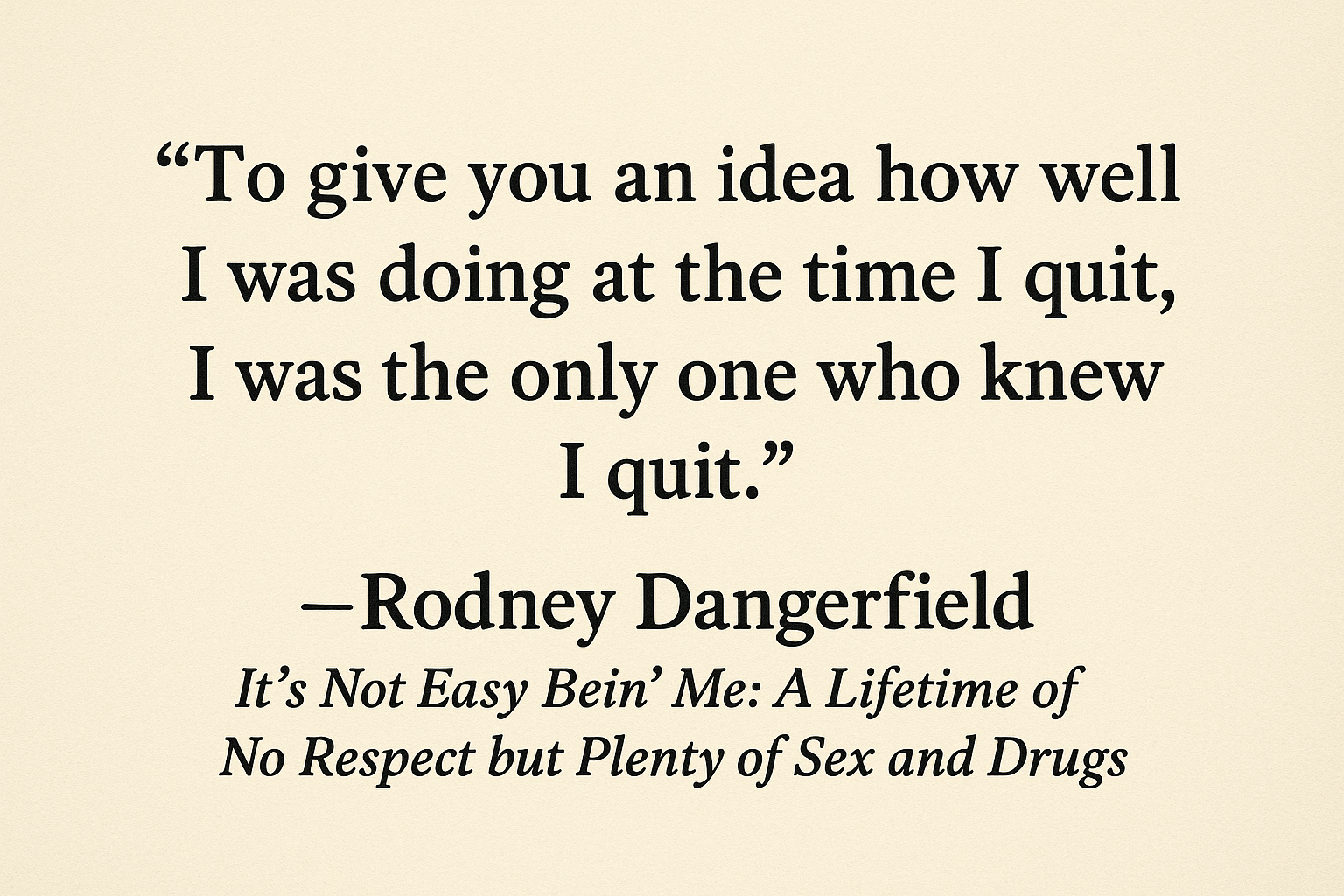
Some of us will never get sick of making art, even if we can never make a living from it, like Miles Davis. Some of us will take a step back and may come back to making art, like Rodney Dangerfield.
When we decide to make art our career, we face this challenge: do we continue if we can’t earn a living? Do we still love making art if it doesn’t bring any rewards? What if we get some mild appreciation but can’t pay our bills – do we keep going? What if we earn a living but aren’t creating work that feeds our souls? Should we consider switching careers?
These are questions that creative professionals often ask themselves – especially early in their careers or when facing career slumps.
The Bhagavad Gita teaches us:
“You have a right to perform your prescribed duties, but you are not entitled to the fruits of your actions. Never consider yourself to be the cause of the results of your activities, nor be attached to inaction.”[13]
This is what keeps many creatives going, even when there is little to no reward. We feel it’s our duty to create something.
Even with this essay, I haven't written it to make money. I wrote it because I feel I need to explore this topic and share my thoughts with you. Of course, I wouldn’t mind earning money from it. I hope it helps me get more work, and I hope it reaches an audience. But even if it doesn’t, I still have to finish it and publish it. I feel it’s my duty, and I do my best to resist inaction.
Giving Chances
One of the biggest challenges of being a creative professional is getting your first gig or job, and your breakthrough opportunity.
In comedy, it was Rodney Dangerfield who gave opportunities to comedians such as Roseanne Barr, Sam Kinison, Jerry Seinfeld, Robert Townsend, and Jim Carrey, among countless others. And in cinema, it was Roger Corman who gave us some of our best filmmakers.
When you enjoy a film made by America’s greatest filmmakers, remember it was probably Roger Corman who trained them.[14] He was often described as the “King of the B-Movies” as many of the films he produced and directed were low-budget, independent, and often falling in the exploitation genre. But more than his films, were the opportunities he gave to aspiring directors – who later became auteurs in their own right.
Working on a Roger Corman set was perhaps the best film school America ever had and maybe ever will. His school roster included:
· Martin Scorsese
· Francis Ford Coppola
· Ron Howard
· Jonathan Demme
· Peter Bogdanovich
· Joe Dante
· Penelope Spheeris
Not to mention, legendary actors like Jack Nicholson and Robert De Niro got their start working on his films.
When you aspire to work in the creative industry, you dream of one day meeting a Roger Corman. You imagine having a father figure who can mentor you, provide opportunities, and give you exposure.
Until his death in 2024, every independent filmmaker in America regarded him as a father figure—and some perhaps as a grandfather figure—as he expressed appreciation for director Ana Lily Amirpour’s debut film A Girl Walks Home Alone at Night, which was released in 2014.
In the age of the internet, making a debut isn’t a problem, but a breakthrough is just as hard. On one hand, we can easily self-publish our content on many different platforms. We can reach wider audiences throughout the globe. But here’s the catch: so can everybody else.
How do we manage to get our self-published novel recognized among the others? Why should our YouTube video be watched instead of the millions of others? And which SoundCloud rapper should be given the most attention?
The challenge to build an audience and retain them is what leads many creators today to quit. Joe Rogan spent years recording his podcast until it reached its current popularity. Of course, he already had some fame due to his career in comedy, acting in the sitcom NewsRadio, and his work as a color commentator. Nevertheless, he still had to be consistent until The Joe Rogan Experience became the most popular podcast in the world.[15]
Many entertainers who are late bloomers have experienced this. Indian actor Boman Irani didn’t debut until his 40s, and he is now regarded as one of India’s top actors.
Samuel L. Jackson got his breakthrough in Pulp Fiction when he was 46, even though he had been acting in films and TV shows since the early 1970s.
Likewise, Morgan Freeman had been acting for several years until his breakthrough in Driving Miss Daisy, when he was 52 – and he had been acting since the 1960s.
The singer Charles Bradley started singing at small venues in the 1970s to supplement his income. His debut album, No Time for Dreaming, was released in 2011 when he was 62. After decades of struggling, he finally gained the recognition he deserved and was able to perform as a professional singer until his death in 2017. It was in the last six years of his life that he finally received his due, and we got to enjoy his art.
None of us aspire to be late bloomers. But understanding that late bloomers exist can often motivate us to keep going even when our instincts urge us to quit.
The challenge these late bloomers faced is that they had to be discovered by others. That’s still true today, but now, we have more chances to capture someone’s attention – although we also face more competition.
In the attention economy, we have to find a way to make our content stand out. This is where creators sometimes have to resort to cheap tactics to attract an audience.
· A polite debate is titled with the word DESTROYED somewhere
· A YouTube video thumbnail must have a woman in a bikini, even if she’s never seen in the video
· One may create content about something they’re not interested in, just to get attention and build an audience
· One may create content that is cheap, vulgar, and sensationalist just because it gets attention
Of course, not every creator resorts to this. There are better ways to attract attention without sacrificing ethics or being deceptive. In fact, now every aspiring creator also needs to become a skilled marketer – until they can hire their own team.
This means that today’s creators have to have multiple skills. A blogger must also understand copywriting – in order to write a catchy title that’ll get clicks. A video creator must understand still images as much as moving images – to come up with the perfect thumbnail.
If we want to work as creators for hire, we often need to learn multiple skills to find the right gig or job. Today’s creator has more opportunities but must keep sharpening their skills.
There might also be a need to reinvent yourself or move into another area of content creation. You might start with an audio-only podcast, but may wish to start shooting video if you want to scale.
I’ve written and ghostwritten books, blog posts, copy, video and audio scripts. Earlier this year, I took a course on speechwriting and wrote and published a few speeches – and then hired professional voice-over artists to record them. All of this to ensure that I have more opportunities available.
My favorite documentary on writing is Obit, which explores the lives of The New York Times’ obituary writers and their craft. Unsurprisingly, I’ve been tempted to learn this art myself—just to add another skill to my repertoire.
In today’s creator economy, we have to keep leveling up if we want to keep getting chances. Even after we hopefully get our breakthrough, we have to keep learning in order to sustain a career.
After comfortably ghostwriting 10,000-word books and 2,000-word blog posts, I had to learn how to craft short taglines for brands, 100-word scripts for ads, and more. Today’s screenwriter might need to learn how to write shorter scripts for web series. And a web series writer may have to master even more condensed scripts for microdramas – which are sure to be the next big trend in the content industry.[16]
We hope to get many chances so we can build a career and earn a good income from our content. Once that’s achieved, we hope to create work that has meaning for others.
Making an Impact
I recall a time during one of my final semesters at university, when I was hanging out with my friend Roland and our mutual friend Lucas. I can’t recall the event completely, but I think we must have been discussing our love of rap music. Well, mine and Roland’s love of rap music – something we’d bonded on ever since we’d known each other.
If I remember correctly, Lucas didn’t share our passion for rap. However, there was one rapper he really liked and wanted to introduce us to. Since I had my laptop with me, he told me about one of the few rappers he did like, and suggested we give him a listen. This was sometime in 2011.
And that’s when I discovered Nujabes.
We listened to his song “Feather,” and immediately, it wasn’t like any of the rap I was used to. It was lighter, gentler, but still profound. The beat was incredible, as were the lyrics. While the song was in English, this was the first time I explored rap music made by a Japanese artist.
I was saddened to learn that this great artist I had just discovered had died in a car accident the previous year. Nujabes released two albums during his lifetime, and a third was issued posthumously.
After a long break, I rediscovered Nujabes this year—listening to him more often. This time, I’ve also learned more about his life and career—reading every article I can find and watching every YouTube video discussing him.
This is because I’ve been listening to Lo-Fi YouTube channels, such as Lo-Fi Girl, which help me relax and stay focused while I’m working.
Looking back at Nujabes’ career reminds me of why we decide to pursue creativity in the first place. Nujabes was known to his fans and collaborators but seldom gave interviews – only one seems to be available, and perhaps it’s the only one.[17]
He didn’t care for fame, and it seemed his reticence to give interviews wasn’t just shyness and modesty, but also because he wanted the focus to be on his work and not his persona.
Nujabes is often regarded as the pioneer or the godfather of the Lo-Fi hip hop genre, and indeed, his work influences many Lo-Fi artists today.
Today, Lo-Fi has become a serious genre—not just enjoyable to listen to but also impactful, which is the ultimate goal of making art. It’s when we make an impact, big or small, that we keep going—even if we aren’t earning a living from our art.
Lo-Fi channels on YouTube are popular because they’ve managed to create a community. They’re one of the few places on YouTube where you can read through the comments and not contemplate suicide after you’re finished!
These channels are quite popular among students, who listen to Lo-Fi streams for several hours while doing their homework or preparing for exams.[18]
Lo-Fi streams have built a community. People open up to each other as they listen to their streams. They share their accomplishments and academic achievements, acknowledging that listening to Lo-Fi music helped them.
Lo-Fi channels are willing to give opportunities to aspiring artists who want their music heard. It’s arguably one of the friendliest communities on the internet, and it all revolves around the love for the art form and its impact.
We might not always earn a lot, and many of us may not earn at all. But if we can collaborate with other talented artists and our work makes an impact – whether on a large group or a single person, we feel accomplished.
I’ve had the pleasure of writing ads, speeches, audio documentaries, and books, and worked with talented voice artists to narrate them.
And best of all, the work has made an impact. Speechwriter Simon Lancaster and Ghostwriter Andrew Crofts showed appreciation for my book Influenceza.
My speech Religious Tolerance VS Religious Acceptance got some appreciation and supportive messages from people who resonated with its message.
Videos I’ve ghostwritten have accumulated thousands and sometimes millions of views. Books I’ve ghostwritten have received five-star reviews on Amazon. While I won’t get credit, that doesn’t matter. It’s rewarding to know that my hard work paid off.
While we might be tempted to say we don’t need validation, the truth is we do need it to sustain a career as creative professionals.
You may feel embarrassed when introducing yourself at a party. You say you’re a creator, but if none of the guests have heard about your film, channel, music, or books, you start to wonder if you’ve achieved anything and begin doubting yourself.
However, when your collaborators enjoy working with you and you reach an audience, you feel like, no matter how slow the train may go, you’re on the right track.
When working with others, you hope that they’ll attain enough fame to attract an audience to your work. When Jennifer Aniston became a star after the premiere of Friends, there was a huge surge in rentals for the film Leprechaun, which she had starred in before her fame. Likewise, Office Space is now a cult film, and Aniston’s fame no doubt helped it gain more attention.[19]
Sometimes, you’ll never receive recognition for your work, but your work will be recognized. For many of us, that’s a dream, as fame is a nuisance, and we don’t care about ourselves; we care about our work. That’s one of the reasons why Nujabes was private – because he wanted his fans to engage with his music and not be too concerned with his persona.
Some of us would rather be an I.A.L. Diamond rather than a Billy Wilder. While you likely may not recognize I.A.L. Diamond if you saw his photo, you’ve enjoyed now-classic Hollywood films that he co-wrote with Wilder, such as Some Like It Hot and The Apartment.[20]
Mickey Rose serves as another example. He co-wrote three films with Woody Allen: What’s Up Tiger Lily?, Take the Money and Run, and Bananas. He also contributed to much of Allen’s stand-up material, including the famous “Moose” bit. Additionally, he wrote a few smaller films and contributed several episodes to popular TV shows.
He worked as a staff writer for The Dean Martin Show and The Tonight Show Starring Johnny Carson, for which he penned nearly 1,000 episodes. Although not as widely known as Allen, he delivered some great comedy films and maintained a steady writing career. [21]
Screenwriter Orville H. Hampton received an Oscar nomination, along with co-writer Raphael Hayes, for their original screenplay for One Potato, Two Potato – a film about an interracial romance, which was rare and taboo in much of the United States at that time.
He had a steady career writing screenplays for the “Poverty Row” films. These were B-grade movies made by major studios. Later, he used the pseudonym Owen Harris to avoid being typecast as a Poverty Row writer.
He had a steady career as a screenwriter and wrote one of my favorite blaxploitation films, Friday Foster. He also worked as a story consultant and additional dialogue writer where needed.[22]
Robert J. Poole is a screenwriter about whom I couldn’t find any information. It seems he only wrote one produced screenplay, and that screenplay was for one of the greatest blaxploitation films of all time, The Mack.[23]
Most creative professionals only seek this. We don’t care about fame or recognition, and many of us prefer to avoid it. We just want to work, earn money, and create great art.
There are, of course, screenwriters who received recognition later in life. David Seidler, who wrote The King’s Speech, finally gained attention for his screenplay. In fact, he won an Oscar and became the oldest winner of the Best Original Screenplay award in 2011. He worked steadily as a screenwriter and teleplay writer, but had only a few notable films to his name. Still, his persistence paid off. He was eventually recognized for his work and helped bring a great story to life.[24]
James L. White produced only one screenplay in his life, which was for the film Ray, about musician and singer Ray Charles. Recognition came late, and his filmography wasn’t extensive. But before he passed away, he gave us arguably one of the greatest biopics in American cinema – the film that won Jamie Foxx an Oscar.[25]
In other words, these artists created remarkable work. Some gained recognition, while others remained unknown outside a small circle of film enthusiasts. However, everyone appreciated their work – and still does.
This is why you should never give up on your art. It’s why you need to keep promoting it. You might be tired of promoting a book you wrote last year or that video you posted the year before, but you never know when it will make an impact and help your career.
Another important effect of creating art is how it influences your life. You learn more about yourself through making art. You also discover what the art is really about – often different from what you first imagined.
When I thought about writing Influenceza, I intended to write a copywriting book targeted toward people who wanted to influence others. It would be a book with explanations and tutorials. As I began exploring the subject further, it turned into a language guide on how language influences us and the different rhetorical techniques. And in my view, it was a much better book than the book I initially had in mind.
This essay started with my intention to write almost exclusively about slop and why slop may not be desirable, but helps us, creative professionals, earn a living. And now, it has turned into this – a reflection on the creative life. And a reminder of why earning a living from your creativity is a privilege… and a blessing.
And that’s why the creative life is worth it.
But I’ve said enough now.
One can’t rest on one’s laurels.
I think I’ll get back to work…
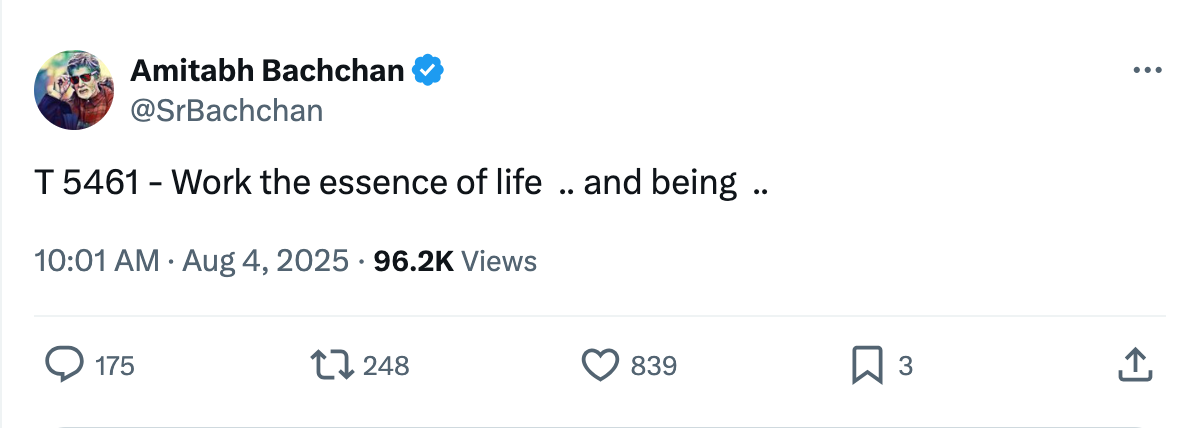
Notes
[1] “Why YouTube Is SLOP Now.” YouTube, YouTube, 12 Sept. 2024, https://www.youtube.com/watch?v=xAo9xen0lS0
[2] Ammous, Saifedean. “Fiat Architecture.” The Fiat Standard: The Debt Slavery Alternative to Human Civilization, The Saif House, 2021, pp. 103–104.
[3] For the purpose of this essay, I’m using the name Macedonia to refer to the Republic of North Macedonia
[4] Smith, Alexander, and Vladimir Banic. “How Macedonian Teens Earn - and Spend - Thousands from Fake News.” NBCNews.Com, NBC Universal News Group, 9 Dec. 2016, www.nbcnews.com/news/world/fake-news-how-partying-macedonian-teen-earns-thousands-publishing-lies-n692451
[5] Knibbs, Kate. “Confessions of an AI Clickbait Kingpin.” Wired, Conde Nast, 7 Feb. 2024, www.wired.com/story/confessions-of-an-ai-clickbait-kingpin/
[6] “Western Balkans’ GDP per Capita on the Rise, IMF Data Shows.” BalkanView, 31 Mar. 2025, balkanview.com/western-balkans-gdp-per-capita-on-the-rise-imf-data-shows/
[7] “Germany GDP per Capita PPP.” Trading Economics, tradingeconomics.com/germany/gdp-per-capita-ppp Accessed 17 Sept. 2025.
[8] Cleese, John. “Creativity in Management.” Lecture, Video Arts, 1991. https://www.youtube.com/watch?v=nvKeu46jgwo Electronically published on 21 Dec. 2024
[9] Cleese, John. Creativity: A Short and Cheerful Guide. Crown, 2020, p. 40.
[10] Perez, Sarah. "Suno CEO Says People Don’t Enjoy Making Music." Futurism, 15 Sept. 2023, https://futurism.com/suno-ai-ceo-making-music
[11] John Cazale acted in the following films: The Godfather (1972), The Godfather II (1974), The Conversation (1974), Dog Day Afternoon (1975), and The Deer Hunter (1978). He died shortly after filming The Deer Hunter at age 42, due to lung cancer.
[12] Speckman, Chris. “A Conversation with Chuck Klosterman.” Booth, Butler University, 14 June 2013, booth.butler.edu/2013/06/14/a-conversation-with-chuck-klosterman/
[13] “Bhagavad Gita: Chapter 2, Verse 47.” BG 2.47: Chapter 2, Verse 47 - Bhagavad Gita, The Song of God – Swami Mukundananda, Jagadguru Kripaluji Yog, India, www.holy-bhagavad-gita.org/chapter/2/verse/47/ Accessed 16 Sept. 2025.
[14] Seitz, Matt Zoller. “Roger Corman’s Greatest Legacy Was Giving so Many People Their Big Break: MZS.” Roger Ebert, RogerEbert.com, 14 May 2024, www.rogerebert.com/mzs/roger-cormans-greatest-legacy-was-giving-so-many-people-their-big-break
[15] SunnyV2. “The Joe Rogan Experience (Full Documentary).” YouTube, YouTube, 1 Sept. 2020, www.youtube.com/watch?v=NDZ8Eu335Sg
[16] Lukyantseva, Zoya. “The Business of Microdramas: Format, Reach, and Roi.” Allrites, allrites, 16 July 2025, www.allrites.com/post/the-business-of-microdramas-format-reach-and-roi
[17] Sound and Recording. “Nujabes ‘Metaphorical Music’ Interview (2003).” Translated by Henkka (Japanese to English), Kumomi, kumomi, 16 Feb. 2024, kumomi.org/2023/02/07/nujabes-metaphorical-music-interview-2003/
[18] Winkie, Luke. “How ‘lofi Hip Hop Radio to Relax/Study to’ Became a YouTube Phenomenon.” VICE, VICE Digital Publishing, LLC, 13 July 2018, www.vice.com/en/article/how-lofi-hip-hop-radio-to-relaxstudy-to-became-a-youtube-phenomenon/
[19] White, Adam. “Jennifer Aniston Didn’t Think Her Career Would Survive ‘Embarrassing’ Killer Leprechaun Movie.” The Independent, 5 Aug. 2021, www.the-independent.com/arts-entertainment/films/news/jennifer-aniston-leprechaun-b1897235.html
[20] Bennetts, Leslie. "I.A.L. Diamond Is Dead at 67; Won Oscar for 'The Apartment'." The New York Times, 22 Apr. 1988, www.nytimes.com/1988/04/22/obituaries/i-a-l-diamond-is-dead-at-67-won-oscar-for-the-apartment.html
[21] Martin, Douglas. "Mickey Rose, TV Writer and Woody Allen Collaborator, Dies at 77." The New York Times, 13 Apr. 2013, www.nytimes.com/2013/04/14/arts/television/mickey-rose-tv-writer-and-woody-allen-collaborator-dies-at-77.html
[22] L.A. Times Archives. "Orville H. Hampton; Movie and TV Screenwriter." Los Angeles Times, 14 Aug. 1997, www.latimes.com/archives/la-xpm-1997-aug-14-mn-22335-story.html
[23] IMDb. "Robert J. Poole." IMDb, www.imdb.com/name/nm0690877/ Accessed 19 Sept. 2025.
[24] Hoad, Phil. "David Seidler Obituary." The Guardian, 19 Mar. 2024, www.theguardian.com/film/2024/mar/19/david-seidler-obituary
[25] Hipes, Patrick. "James L. White Dies: ‘Ray’ Screenwriter Was 67." Deadline, 23 July 2015, deadline.com/2015/07/james-l-white-dead-ray-screenwriter-1201484279/
Copyright (excluding quotes) 2025 Raghav Suri. All Rights Reserved.
Find more work at RaghavSuri.com ; Find more audio work at SuriAudio.com
Read by Ram Ranjini. Find more of Ram's works and hire him for voice over services via RamRanjini.com and on Instagram.
